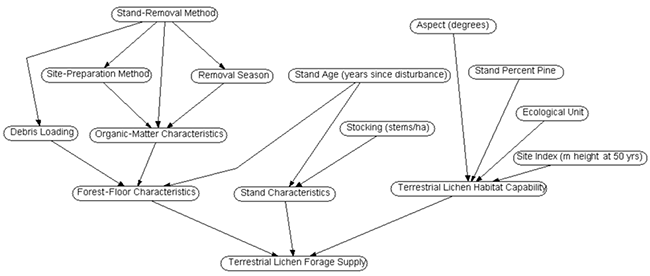4.3.10 BAYESIAN ANALYSIS


Bayesian Belief Networks are diagrams depicting influence, constructed graphically as networks of variables and their interactions, referred to as nodes linked with arrows representing a wide range of influences on the system being examined.
Bayesian belief networks can display correlative linkages and explore causal relations among variables, such as actions on system components and alternative outcomes [Nyberg et al., 2006]. By identifying the system variables or “nodes”, bayesian belief networks can be used to identify those variables that have the greatest influence on outcomes, thus they can focus research or action by decision makers within their management decisions and strategies.
Their ability to represent and communicate different potential outcomes of management options makes them valuable analytical tools for managers.
They have been applied in ecological modelling and natural resource management, for example, to represent species-habitat relationships and population viability and to depict the influence of alternative management activities on key ecological variables to help support researchers and managers, respectively [McCann et al., 2006].
The diagram below depicts various environmental factors and forest management measures upon lichens in British Columbia [Nyberg et al., 2006]:

Bayesian belief networks allow the structuring of the internal logic of scenarios by using conditional probabilities on the relationships between variables (logical and strength). These conditional probabilities can be gathered through empirical data, stakeholder input, expert judgement or model output. Such networks thus offer a way of combining both quantitative and qualitative data within a single framework, and of expressing the uncertainties associated with the underlying assumptions and the impacts that appear to follow from them.
Bayesian modelling is probabilistic, and therefore, can include data and other sources of information even though either may be incomplete [McNay R.S. et al., 2006]. In general, bayesian belief networks consist of nodes and linkages, where nodes represent environmental correlates, disturbance factors, and response conditions. All nodes are linked by probabilities. Input nodes (the range and environmental prediction variables) contain marginal (“prior”) probabilities of their states determined from actual existing conditions; intermediate nodes (e.g., describing attributes of caribou range) contain tables of conditional probabilities based on empirical studies and (or) expert judgment; and output nodes (caribou range values) are calculated as posterior probabilities. Some input nodes, which we refer to as “management levers,” can represent correlations to the environment that are dynamic either through unmanaged or managed disturbance. These levers can be adjusted based on scenario simulations to estimate management effects during bayesian belief networks applications. [McNay R.S. et al., 2006]
Bayesian belief networks can serve many purposes, from illustrating a conceptual understanding of system relations to calculating joint probabilities for decision options and predicting outcomes of management policies. Nevertheless, when properly used, Bayesian networks can benefit most adaptive-management teams by promoting a shared understanding of the system being managed and encouraging the rigorous examination of alternative management policies. [Nyberg et al., 2006]
Time: this depends on the need or not to develop the network of interactions before running the survey and the choice to run the survey during workshop(s) or on line. Starting from the building of the network of interdependencies for a specific issue and going through an online survey may require 6 to 8 months. The short version: a small expert group to adapt a pre-existing view of the issue and one large workshop to run and interpret the survey can be done in 3-4 months including writing the narrative.
Technical level: 4/4
Advantages: inclusive in terms of engaging experts into the definition of the problem; provides quantitative estimates (probability chains) that can be used to explore alternative pathways towards a given future.
Bayesian belief networks as a tool for researchers and managers can be considered to have considerable merit, in summary they can [McCann et al, 2006]:
- Represent and combine empirical data with experts’ understanding of ecological systems;
- Graphically express complex relationships and problems in resource management;
- Address, in a structured way, uncertainties within systems;
- Structure and evaluate alternative decisions within the system;
- Be created and amended with ease;
- Allow flexible use of information, and can be used in both data-rich and data-poor situations, however in the latter case, caution is advised;
- Present complex systems through graphical representation that can be easily understood by various stakeholders, who may not have training in the underlying scientific disciplines, and facilitate important management-related discussions.
Limits: requires some mastering of the approach and methodology to be seriously implemented. Some temporal dynamics and relationships can be difficult to illustrate within a bayesian belief networks; similarly feedback functions cannot always be represented within these models. Models can be easily developed entirely from expert judgement, with an unknown degree of bias and inaccuracy. Where this is the case, judgements need to be recorded to validate the basis for the model’s structure. Nodes in the model, for example, should be empirically observable, quantifiable or defensible [McCann et al., 2006].
Resources needed: organize 2 or 3 meetings of small "expert" groups to develop the structure of the problem and questionnaire. The resources required are a meeting facilitator and statistician with knowledge in Bayesian approach; a meeting or online survey to complete the questionnaire; a meeting to run the scenarios. Time must then be allocated for writing the narratives, which will be based on results of the scenarios.
Advice: work with somebody familiar with developing questionnaires for Bayesian statistics and a facilitator familiar with running scenario discussions.

Example of the North Devon case study use of the Bayesian belief networks

Link

